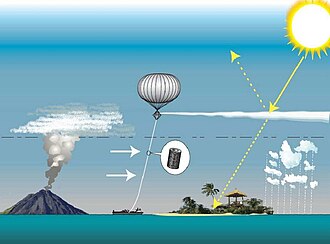Methods
Carbon dioxide removal

Carbon dioxide removal (CDR) is a process in which carbon dioxide (CO2) is removed from the atmosphere by deliberate human activities and durably stored in geological, terrestrial, or ocean reservoirs, or in products. [17] : 2221 This process is also known as carbon removal, greenhouse gas removal or negative emissions. CDR is more and more often integrated into climate policy, as an element of climate change mitigation strategies. [18] [19] Achieving net zero emissions will require first and foremost deep and sustained cuts in emissions, and then—in addition—the use of CDR ("CDR is what puts the net into net zero emissions" [20] ). In the future, CDR may be able to counterbalance emissions that are technically difficult to eliminate, such as some agricultural and industrial emissions. [21] : 114
CDR includes methods that are implemented on land or in aquatic systems. Land-based methods include afforestation, reforestation, agricultural practices that sequester carbon in soils (carbon farming), bioenergy with carbon capture and storage (BECCS), and direct air capture combined with storage. [21] [22] There are also CDR methods that use oceans and other water bodies. Those are called ocean fertilization, ocean alkalinity enhancement, [23] wetland restoration and blue carbon approaches. [21] A detailed analysis needs to be performed to assess how much negative emissions a particular process achieves. This analysis includes life cycle analysis and "monitoring, reporting, and verification" (MRV) of the entire process. [24] Carbon capture and storage (CCS) are not regarded as CDR because CCS does not reduce the amount of carbon dioxide already in the atmosphere.Solar radiation modification

Solar radiation modification (SRM) (or solar geoengineering or solar radiation management), is a group of large-scale approaches to reduce global warming by increasing the amount of sunlight (solar radiation) that is reflected away from Earth and back to space. Among the potential methods, stratospheric aerosol injection (SAI) is the most-studied, [25] : 350 followed by marine cloud brightening (MCB); others such as ground- and space-based methods show less potential or feasibility and receive less attention. SRM could be a supplement to climate change mitigation and adaptation measures, [26] : 1489 but would not be a substitute for reducing greenhouse gas emissions. [27] SRM is a form of climate engineering or geoengineering, and might be able to prevent some kinds of tipping. [28]
Scientific studies, based on evidence from climate models, have consistently shown that SRM could reduce global warming and many effects of climate change. [29] [30] [31] However, because warming from greenhouse gases and cooling from SRM would operate differently across latitudes and seasons, a world where global warming would be reduced by SRM would have a different climate from one where this warming did not occur in the first place. SRM would therefore pose environmental risks, as would a warmed world without SRM. Confidence in the current projections of how SRM would affect regional climate and ecosystems is low. [26] : 1491–1492Glacial geoengineering

Glacial geoengineering is a set of proposed geoengineering that focus on slowing the loss of glaciers, ice sheets, and sea ice in polar regions and, in some cases, alpine areas. Proposals are motivated by concerns that feedback loops—such as ice-albedo loss, accelerated glacier flow, and permafrost methane release—could amplify climate change and trigger climate tipping points. [32] [33]
Proposed glacial geoengineering methods include regional or local solar radiation management, thinning cirrus clouds to allow more heat to escape, and deploying mechanical or engineering structures to stabilize ice. Specific strategies under investigation are stratospheric aerosol injection focused on polar regions, [34] marine cloud brightening, [35] surface albedo modification with reflective materials, [36] basal interventions such as draining subglacial water or promoting basal freezing, [33] and ice shelf protection measures including seabed curtains. [37]
Glacial geoengineering is in the early research stage and many proposals face major technical, environmental, and governance challenges. [35] Supporters argue that targeted interventions could help stabilize ice sheets, slow sea-level rise, and reduce the risk of passing irreversible thresholds in the climate system. At the same time, experts caution that the effectiveness of these methods remains highly uncertain and that interventions could produce unintended side effects. [33] Glacial geoengineering is generally considered a possible complement to, not a replacement for, efforts to reduce greenhouse gas emissions. [34] [35]